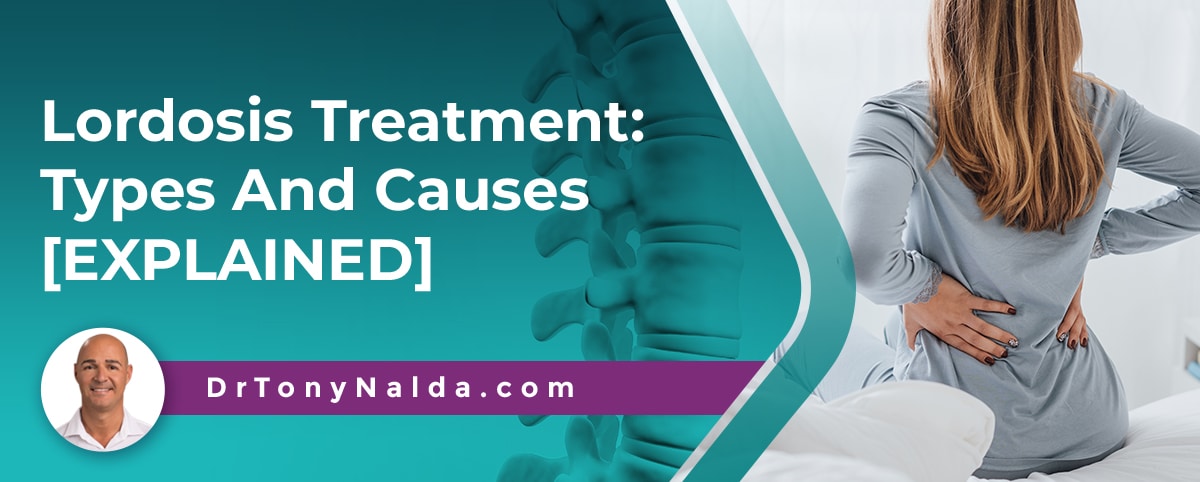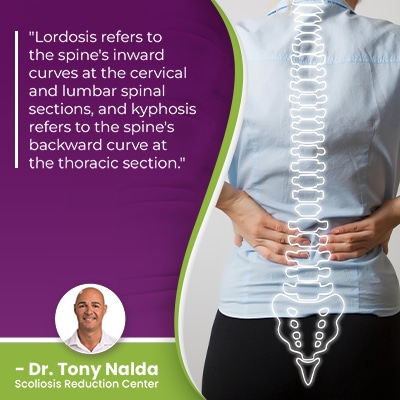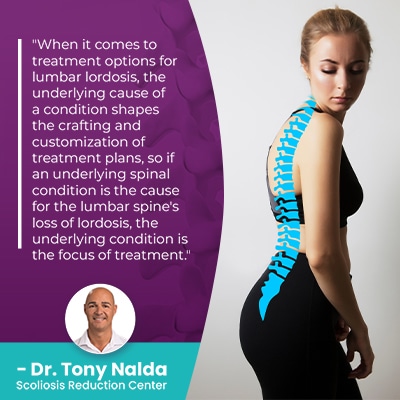Lordosis Treatment, Types And Causes [EXPLAINED]

The spine is naturally curved at each of its main sections and as one long structure, the health of each spinal section is dependent on the health of the others. The spine's inward lordotic curves are found in the neck and lower back, and these spinal sections have unique roles to play in preserving spinal health and function. Continue reading to learn more about the spine's healthy curves, and how their loss can affect the spine.
The spine's natural curves help it stay strong and functional, and lordosis refers to the spine's inward curves at the cervical and lumbar spinal sections. If a patient's level of cervical lordosis or lumbar lordosis falls beyond a normal range, the spine's biomechanics are disrupted and can cause a number of symptoms.
Before getting to the specifics of lordosis types, causes, and symptoms, let's first take a look at the basic structure of the spine.
Table of Contents
Spinal Structure and Anatomy
The spine consists of vertebrae (bones) stacked on top of one another in a straight and neutral alignment, and these vertebrae are separated by intervertebral discs; the discs give the spine flexibility, structure, cushioning to prevent friction, and act as the spine's shock absorbers.
Disc degeneration is, in fact, the root cause behind the development of a number of spinal conditions/issues; the spinal discs are an important part of the spine's ability to maintain its natural curves/alignment.
There are three main spinal sections: the cervical spine (neck), thoracic spine (middle/upper back), and the lumbar spine (lower back).
Each of the spine's main sections has its own characteristic curvature type, which is why when a healthy spine is viewed from the front and/or back, it will appear straight, but when viewed from the sides, it will take on a soft 'S' shape.
Now, there are two main spinal curvature types: an inward curve that bends towards the body's center, in a standard 'C' shape, and one that bends outwards, away from the body's center, in a reverse 'C' shape.
Lordosis vs Kyphosis
 Lordosis refers to the spine's inward curves at the cervical and lumbar spinal sections, and kyphosis refers to the spine's backward curve at the thoracic section.
Lordosis refers to the spine's inward curves at the cervical and lumbar spinal sections, and kyphosis refers to the spine's backward curve at the thoracic section.
The thoracic spine is the largest spinal section. The cervical spine acts as the bridge between the brain and the rest of the body, has to support the weight of the head, and facilitates the head's ability to turn side to side and look up and down. The lumbar spine has the added responsibility of supporting the weight of the entire trunk, the spinal sections above, and its vertebrae feel the effects of bending, lifting, and twisting motions.
So as you can see, along with different curvature types, each spinal section has its own unique characteristics and roles to play in preserving overall spinal health and function.
The size of spinal curves can fall within a healthy range, varying from person to person, but if a person's level of lordosis becomes under- or over-pronounced, this becomes problematic because it disrupts the biomechanics of the entire spine by introducing uneven forces.
A healthy range of cervical lordosis is considered to be between 20 and 35 degrees, and a healthy range of lumbar lordosis is considered to be between 40 and 60 degrees, and the type of lordosis is determined by its location.
Cervical Lordosis
A diagnosis of cervical lordosis means the neck has lost its natural lordotic curve, becoming excessively straight, and this can cause a number of problems.
When the cervical spine is excessively straight, this disrupts its ability to support the weight of the head, can cause the thoracic spine to also become excessively straight, and exposes the cervical discs to uneven pressure, causing excessive rates of degeneration.
If the neck loses its healthy curve and becomes excessively straight, this shifts the posture of the neck forward, known as forward head posture, and any shift forward in neck-posture a little as one inch is though to increase the weight of the head on the cervical spine by approximately 10 pounds; over time, that can cause a lot of excess wear and tear on the individual vertebra and discs of the cervical spine.
Symptoms of Cervical Lordosis
Symptoms of cervical lordosis can vary from patient to patient but can include neck pain, shoulder pain, muscle pain in the neck, shoulders, and upper back, and this can be caused by a muscle imbalance.
The unnatural change to the cervical spine's curvature can cause its surrounding muscles to be pulled in different directions, and this can cause the development of a muscle imbalance and/or sore and strained muscles.
Tension headaches can also be a symptom of forward head posture and a loss of cervical lordosis, and a reduced range of motion in the neck is also common.
Additional symptoms of cervical lordosis include neck-muscle pain and shoulder pain from muscles being pulled in different directions; the muscles that surround the spine help it to stay aligned and maintain its natural curves and alignment.
Treatment Options for Cervical Lordosis
A loss of cervical lordosis can be caused by chronic poor posture, carrying excess weight, and/or the presence of a degenerative spinal condition.
Treatment for cervical lordosis has the end goal of restoring the cervical spine's lordosis so a healthy curvature in the neck is maintained.
A combination of condition-specific chiropractic care and physical therapy is a common treatment response as this means chiropractic care that works towards adjusting the position of the cervical spine's most-affected vertebrae, and physical therapy can help strengthen the muscles of the neck so they can optimally support the cervical spine, address any related muscle imbalance, and improve posture.
Lumbar Lordosis
A diagnosis of lumbar lordosis means the lower back has lost its natural lordosis, and while lordosis also affects the cervical spine, it more commonly affects the lumbar spine, and this is because the vertebrae of the lumbar spine are under a lot of stress.
As mentioned, the lower back has to support a lot of weight, and the effect of a variety of potentially-strenuous movements are also felt by the vertebrae of the lumbar spine; this is why it's said that everyone will experience issues with lower back pain at some point in their lives.
Lumbar lordosis is also commonly referred to as swayback due to the related postural changes that give the body a swayback appearance.
Symptoms of Lumbar Lordosis
People with lumbar lordosis can experience a variety of symptoms, and when lying flat on the floor, there will be a noticeable gap between the spine and the surface below, and this is due to the lumbar spine's excessive level of lordosis.
The main symptom is the visual effect of causing a swayback appearance where the abdomen protrudes forward excessively, and the buttocks project backwards excessively.
Other symptoms of lumbar lordosis can include:
- Sensations of numbness/tingling that typically affects the lower body (nerve compression)
- Electric shock-like pains
- Muscle weakness in the lower back and abdomen
- Lower back pain
- Issues with bowel or bladder control (more common in severe cases)
Lumbar lordosis can have a number of causes, and treatment needs are shaped around causation.
Treatment Options for Lumbar Lordosis
 Common causes of lumbar lordosis can include chronic bad posture, carrying excess weight, leading a sedentary lifestyle, and the presence of an underlying spinal condition such as kyphosis (spine can put in compensatory curves), degenerative disc disease in the lumbar spine, and spondylolisthesis (a vertebral body can slip forward onto the vertebra below).
Common causes of lumbar lordosis can include chronic bad posture, carrying excess weight, leading a sedentary lifestyle, and the presence of an underlying spinal condition such as kyphosis (spine can put in compensatory curves), degenerative disc disease in the lumbar spine, and spondylolisthesis (a vertebral body can slip forward onto the vertebra below).
When it comes to treatment options for lumbar lordosis, the underlying cause of a condition shapes the crafting and customization of treatment plans, so if an underlying spinal condition is the cause for the lumbar spine's loss of lordosis, the underlying condition is the focus of treatment.
If lifestyle issues such as obesity, chronic poor posture, and a sedentary lifestyle are to blame, lifestyle guidance, chiropractic care, and physical therapy can help.
Chiropractic care can help by working towards adjusting the most-tilted vertebrae of the excessive lordotic curve so the spine is aligned properly, and physical therapy can help strengthen abdominal muscles that support the lumbar spine, improve posture, address any related muscle imbalance, and is also known to activate certain areas of the brain for improved brain-body communication.
Conclusion
When the spine loses a healthy curve, it can respond by putting in bad curves, and this disrupts the biomechanics of the entire spine.
The spine's natural lordosis is found in the cervical and lumbar spinal sections, and if the spine loses its natural lordosis, becoming under- or over-pronounced, problems occur.
Cervical lordosis is problematic because it disrupts the neck's ability to optimally support and distribute the weight of the head; it also exposes the spine and its surrounding muscles to uneven forces, and this means uneven wear and tear: excessive rates of spinal degeneration.
Lumbar lordosis is problematic because it disrupts the lower back's ability to support the sections above and engage in a wide range of flexible movement, and as the lumbar vertebrae are already stressed, this can cause a lot of pain.
When nerve compression is involved, an unnatural spinal curve can cause a number of painful sensations, including numbness and sharp shooting pains felt throughout the lower body.
When it comes to restoring a healthy range of cervical lordosis and lumbar lordosis, here at the Scoliosis Reduction Center, this involves first determining a condition's underlying cause, shaping a treatment plan around it, and combining the benefits of condition-specific chiropractic care, physical therapy, and lifestyle guidance.
Dr. Tony Nalda
DOCTOR OF CHIROPRACTIC
After receiving an undergraduate degree in psychology and his Doctorate of Chiropractic from Life University, Dr. Nalda settled in Celebration, Florida and proceeded to build one of Central Florida’s most successful chiropractic clinics.
His experience with patients suffering from scoliosis, and the confusion and frustration they faced, led him to seek a specialty in scoliosis care. In 2006 he completed his Intensive Care Certification from CLEAR Institute, a leading scoliosis educational and certification center.
About Dr. Tony Nalda
 Ready to explore scoliosis treatment? Contact Us Now
Ready to explore scoliosis treatment? Contact Us Now





